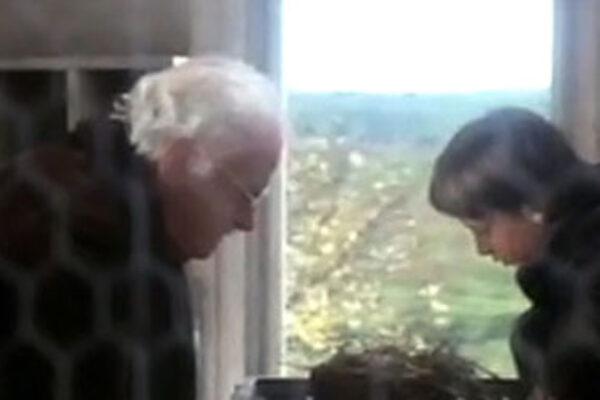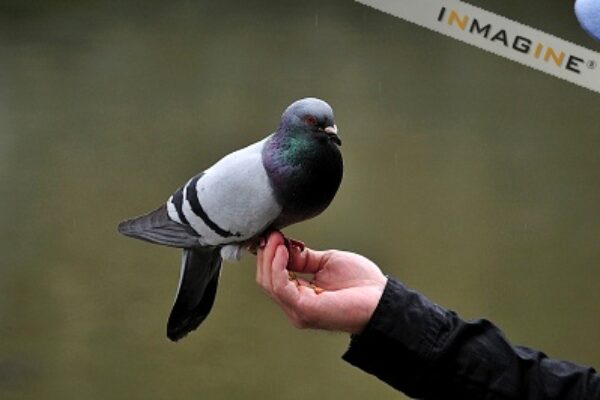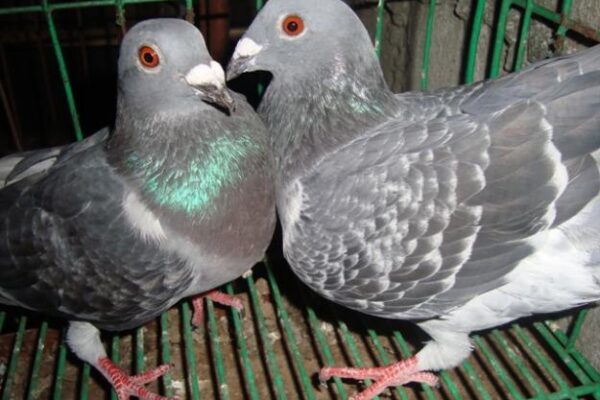Space Age Ventilation – Loft Atmosphere
 On a visit ten years ago the Hungary to the city of Kaposyar, I met the well known German pigeon photographer Gerhard Schlepphorst. Several times we talked at length about which fanciers in Germany or Holland came up with the finest performances. During on of these exchanges the name of Van Ravenstein surfaced. Gerhard mentioned this fancier, week after week, he punished the competition by minutes with several pigeons on top.
On a visit ten years ago the Hungary to the city of Kaposyar, I met the well known German pigeon photographer Gerhard Schlepphorst. Several times we talked at length about which fanciers in Germany or Holland came up with the finest performances. During on of these exchanges the name of Van Ravenstein surfaced. Gerhard mentioned this fancier, week after week, he punished the competition by minutes with several pigeons on top.
Then he added that the loft in which these pigeons are housed with its so called electronic “environmental control” was the best he had ever seen. It was impossible for him to explain exactly what the term “environmental control” meant so he advised me to go and see it with my own eyes.
Promptly I made an appointment and it was on a beautiful day in January that I had the satisfaction of meeting Van Ravenstein in person. This man accomplished an extraordinary collection of victories. The race program put together for the old bird racers embraces 13 races. He had come in 1st no less than seven of these races in 1979, for example , and every one of them had sizable numbers of birds participating, while the distances varied from 150 to 400 miles.
Five times he captured the first six prizes, while in two races he managed to win all of the top ten positions. In my opinion these are remarkable accomplishments and they were won by offspring from super pigeons coming from the ranks of Belgian champion fanciers, mainly Jules Rijcaert and Gust Hofkens.
My host was a little dumbfounded when he realized the stimulus for my visit wasn’t because of these racing results or to examine his pigeons. I told him the purpose and together we went upstairs to his loft and the installed “environmental control”. The integrated installation consists of a collection of popes on top of the loft. A ventilation fan at the loft end constantly sucks air away. The upstairs area has been completely closed off to prevent unwanted drafts and is also well insulated for a more even temperature. The outside air enters the loft by way of fresh air pipes located on both sides of the roof.
To ensure that the same kind of air is present in most areas of the loft, the distance to the “climatic air control duct” has been made as long as possible. There is a heating system in the loft and the temperature all year round never drops below 60 F. As long as the temperature remains the same, the relative humidity will drop, but never below 55%. With respect to the living quarters of his pigeons, Van Ravenstein elects to keep all conditions constant, year round.
Relative Humidity
The relative humidity (RH) of the air is a number which indicates , in percentages, how much of the maximum quantity of water the air is absorbing, at a fixed temperature. Although this may look complicated, it is very easy to read the number off a hygrometer. There are afew things that every fancier should recognize about the RH factor. In the first place, the most favorable RH for pigeons is found between 60 and 65%. It is very important to have an unchanging RH if you want to keep your pigeons in form because when it gets too low ( below 40%), or too high (above (90%) for a period of time, the affect can be harmful to the general health of the birds.
It is crucial to know that the RH is closely related to the temperature. Temperature fluctuations alter the RH. For that reason we should try to keep the temperature in our lofts under control as much as possible. It is a well known fact that there is a linkage of top performances by our pigeons and the ideal temperature. When everything is right they eat less and lose body weight, in other words, they acquire fitness!
Every day the environment in our lofts is influenced by the following factors: the air temperature, the different gaseous ingredients of the air, the percent humidity, and the lighting of the loft.
Next, we should examine which factors help establish a constant temperature in our lofts: The insulation and building materials in the loft construction, the amount of ventilation, the number of pigeons that are living in the loft, the heat their bodies are producing, and the availability of any supplementary heating.
Not everyone is able to bring into their lofts an extra source of heat, but, we can always allow the sun to help us. This will generate a beneficial difference and it will not harm the pigeons. Many of you probably aren’t a great deal interested in the laws of Nature, but, whenever you decide to get to the bottom of something you may as well understand the principles from the start. The purpose of this article and the more technical details to follow later on is to provide you with an in depth study.
Purpose of Ventilation
The purpose of ventilation is to: Make fresh oxygen available to the respiratory system. Remove the exhaled gases and the gases produced by the droppings. Rid the loft of excess moisture so the RH will stay within the permissible levels. Help maintain the temperature at the proper level.
You may have to ventilate year round when you want to provide the loft with new oxygen and at the same time remove the accumulated harmful gases. Especially in the summer, when the temperature outside is high, ventilation is essential to remove the heat the pigeons produce. As the temperature rises the level of oxygen in the air goes down. For this reason we must ventilate more. During the winter, though we ventilate as little as possible by reason of the fact that we want to keep the loss of heat to a minimum. This minimum amount depends on the number of pigeons in the loft and the odor they produce.
Mechanics of Ventilation
A body of air which is trapped inside a closed area will put pressure on all sides whenever the temperature in that area is higher than the outside temperature. Heat is produced by the pigeons, the sun’s rays that penetrate the loft, and when available, other sources of heat. Within the loft the air will layer itself and the warmest layer will rise to the ceiling, while the coolest air is found near the floor. Whenever warm air meets the outside air and exchange will take place. Because of the built up pressure the warmer air will move out from the top of the loft while the colder air comes back in at the bottom, thus replacing the warmer and lighter air inside the loft. This, in brief, is the is the principle of natural ventilation.
Natural ventilation is the result of the temperature differences or a difference in weight between the air inside the loft and the outside air. If the difference is extensive the exchange happens quicker and as a result you have more natural ventilation.
The amount of natural ventilation can also be increased by the so called “chimney effect”. This effect is based on the idea that air pressure differences also depend on the difference in height between the air outlet and air intake. This difference can be increase by way of ducts.
Pressure Caused by Wind
There is more pressure placed on the side of the loft on which the wind is blowing and less pressure on the opposite side. When the ventilation openings are not properly covered, or in some way protected, they will help bring about unwanted side ventilation, because of the wind pressure. Another word for this type of ventilation is drafts. Nobody needs this! The best thing to do is locate the loft in relation to the prevailing winds so that this problem is kept to a minimum.
Ventilation System Requirements
Proper ventilation should: Be able to maintain the correct quality of air. Provide good quality air to all corners of the loft. Never cause drafts. Be both efficient and easy to regulate.
Taking the above points one by one and checking them against the ventilation system of Van Ravenstein, we can see that he scores high on all counts. The incoming air is heated, resulting in a loss of moisture, resulting in a more constant RH. The distance between the place where the air enters and the exhaust pipe opening is of considerable length. The air enters at the lowest possible point, the floor. The amount of air which is sucked away through the pipe openings is the same throughout the loft. It doesn’t matter if a hurricane is blowing, resulting in great pressure, this will not influence the ventilation causing it to suck away great amounts of air. The amount of air to be removed can be regulated exactly with a variable dial connected to the ventilator.
When I was with Van Ravenstein in the loft I experienced first hand the favorable quality of air. By looking at the pigeons it appeared that they were very comfortable in their home. Before the installation of the “climate control”, Van Ravenstein , as many of us, had ventilation problems, or to use the correct term, did not have the right climate in his loft. After the installation of the ” climate control system” the following remarkable changes took place: No matter how many pigeons were in the loft, all signs of respiratory disease of any kind disappeared. Year after year the pigeons had a terrific moult and the loss of down feathers was super all year long. The color of the pigeons’ wattles were much whiter, compared with other years. The speed of recovery after a race improved as well.
Why do birds bounce back so much faster? A racing pigeon uses a lot of oxygen in relation to its body size. In the summer when the outside temperature is usually the same as the inside temperature, not much ventilation takes place. It is a well known fact, a pigeon that is racing, needs a good quantity of oxygen. The lofts interior climate is often decided by the fancier’s person al preference. This isn’t that strange, because when humans don’t feel that comfortable in a certain environment, then the same holds true for the birds.
One has to set the climate control almost daily. Every time the outside temperature rises, the percentage of oxygen in the air goes down, more moisture evaporates, and more ammonia type gases escape from the droppings. I installed in my lofts the same type of ventilation system. I’ve been working with it for over ten years now and the above conclusions were seen in my lofts.
In a loft of less than 126 square feet I have housed 130 young birds. They were healthier than they had ever been before, eager to fly and not the slightest indication of a wet nose or a watery eye. During the ten years after the installation of the climate control system the racing results of my youngsters were really amazing.
Conclusion
Installing such an electrical system and having it set properly is not that simple and better left to the experienced. I would discourage a ” too eager” do-it-yourself approach.
Constructive Guidelines
The total air content of the loft should be replaced 25 to 30 times per hour. This is the highest dial setting when, in the summer, it is very hot outside and you have the maximum number of pigeons in your loft. The ventilator should have a maximum capacity of 25 to 30 times the total loft air content. The regulator or dial, should be step free, sometimes referred to as infinitely variable. The loft has to be completely air tight, except for some air inlets needed to allow fresh air to enter, and these outlets should be located at the lowest possible level, as far away from the pigeons as possible. The ventilator exhaust vent should have a diameter of at least 10 inches. A smaller diameter would create too much resistance and have a negative effect on the ventilator’s capacity. The area of the cross section of the exhaust duct should be equal to the sum of the areas of all the ducts exhausting the air out through the ventilator. The first opening( the opening furthest away from the ventilator) in the duct should be 12 square inches. A smaller opening than this would be inefficient. The larger openings increase in size by a constant feature. Assume that the area cross section of the duct measures 400 square inches. The sum of the areas of all the duct openings should not exceed that number (to make more openings would not have any effect at all). We know the size of the first opening, which should be 12 square inches or approximately 3 inches by 4 inches. Then the following openings should be 4″X4″, 4″x5″, 4″x6″, 4″x7″ etc., until you reach to total amount of 400 square inches. By using this principle you can figure out how many openings you need in the duct and then divide them evenly along the length of the duct. As long as the ratio is correct the system will work.
Space Age Ventalation – Loft Atmosphere By Steven van Breemen
The Leading Online Pigeon Racing and Racing Pigeons Magazine – The Pigeon Insider









Ventilation is key in any loft no matter where you live. But all pigeon flyers have to take note of where they live l. Every part of your climate is based on where you live . It’s Different in the south as it is in the north. Other factors to be considered should also be your elevation. The weather everywhere is changing. Which will require you to constantly make adjustments.
I also use ionizers which makes the air a little cleaner. Any thing you do to make air quality in your loft good is better than doing nothing at all. Also important thing mentioned is about drafts. Thanks for the article I forward them to all the new guys just starting up in our club.
Hi Chris i have turbines on all my lofts and vents down below that i can open and close the only
thing i find in Canada and the Eastern US would be the same when your weather in the summer is
well over thirty it is very hard to control humidity i know in the Uk and some other countries they can
have warm weather but low humidity it is easier to control.But for most part are birds are flying in
this also Brad.
Turbine vent in my OPINION it is probably the worst ventilation system, also I had a mink get through the turbine into my loft. I hope you got your ventilation right.
Hi,
It seems your gentle man have to much money to try all this fancy tricks of ventilation. I race in a loft half open in front and at the back two inch open on top but only 3 pigeons in1000x2000x2000mm in widowhood boxes and most 1,2,3,positions was mine well that was in the nine thees and now this year i start up with 4 pairs in the same loft but the nearest club is 180km i try to start a new club , ow what i forget to mention only with 12 widowhood cocks and their hens . well my thinking is the space in the loft is the thing that counts , plenty of fresh air
wish you all the best for the new season
My new brick face and stainless steel dowel front racing lofts x2 and breeding lofts x2, I’ve enlisted a professional air flow engineer that specialises in this only. Expensive, yes. But if I want to win races I started off with size then quality of lofts it self. In other words only the best of the best will do what the construction of my racing pigeon lofts is concerned. 2nd to these is location is extremely important to me. In this case on my brother’s huge distribution warehouse with its huge h/d concrete roof that is 5 storeys high. Ventilation is uncompromised. Here I spend it big. This include in each nest box too. The total cost in just building and kit it out 100% strictly to my liking at the equivalent of $785’990.00 USD of our own money of which almost strip my bank balance. Off this money I would say a great part of it my pigeons has worked for and not me. This racing pigeon lofts will be fully completed at the end of August 2012. All nest boxes is build out of stainless steel and its high spec too. Currently I try to global patent my design of nest boxes. It futures ventilation, lighting,
usb ports, night vision very small cameras, Hopper and drinker, walk around, etc… All of nest parts is removable for easy cleaning. Once completed and I get my global patent I will put my new racing pigeon lofts on YouTube. I will let you know when I’ve put it on YouTube. Meaning I will fly over to South Africa to see my design loft outside and inside with my digital camcorder. Can’t wait.
I am no pro, but seems logically if you push air inside your loft, you increase air pressure.
If you pump air out, you creating a little vacuum or lowering air pressure.
Is it good for birds?
Nice Website!
The Best!